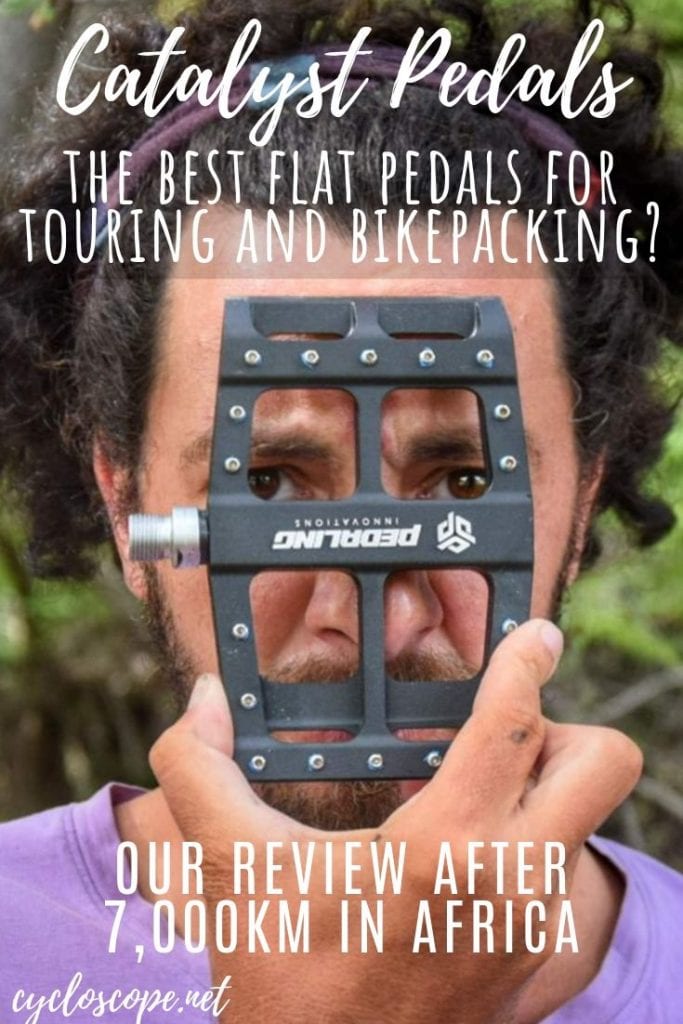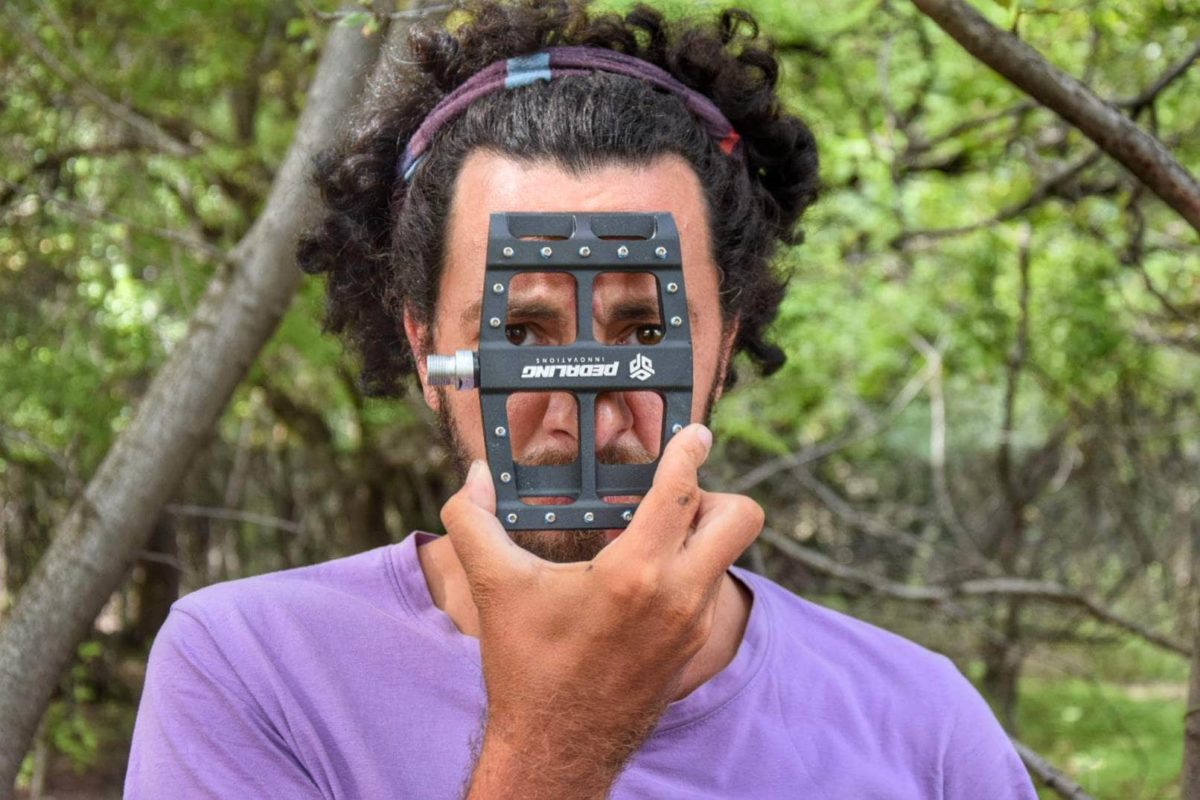Last Updated on 21 June 2024 by Cycloscope

Our experience w. Catalyst Pedals by Pedaling Innovation after 6,000km in Africa: a thorough review. Are they the best flat pedals? Where is the innovation?
The biggest pedals on the market, the Catalyst by Pedaling Innovation look impressive at first sight – they really stand out and make your bike noticed. For our African bicycle trip, we really didn’t want to use clipless, the often terrible road conditions make that a very dangerous choice in my opinion, you really want to be able to put your feet on the ground as quickly as possible on the sandy or bumpy tracks.
Disclosure: Some of our articles contain affiliate links. This comes at no additional cost for you and helps us keep this website up and running. (as Amazon Associates we earn commission from qualifying purchases)
How we compile our gear guides: during the almost 10 years of cycloscope.net our team personally tested dozens of similar pieces of gear. For what we can't test personally, we involve other people in the cycling community to give their feedback and opinion about gear they have used. Our decade-long experience in bicycle touring enables us to find the key cons and pros of every product we mention.

At the same time, the smaller pedals we used on our cycling trip in Europe on our Stanforth Bikes were really not grippy enough, slippery when wet, and didn’t offer a big enough surface. We wanted something more stable, where our feet could lay safe in all kinds of conditions, so we came across the Catalysts. We decided to try them and got two pairs from James at Pedaling Innovation, founder of the company and inventor of the pedals, with the promise to write a field review about the Catalyst Pedals.
Now, after 5 months and 6,000km of very diverse African roads, I feel I can say something about them – I hope this review will be helpful in understanding if these pedals are or are not for you. So, are these the best pedals for bicycle touring?
Description of the Catalyst Pedals

With a platform size of 143mm x 95mm, the length of the Catalyst Pedals is at least 18mm longer than the next largest pedal. They are 16mm thick and pretty heavy at 505g x pair. The grip is guaranteed by 18 pins per side, all on the edges and none in the middle. Pins are 4mm long (2mm out) but the company provides spare pins which are double the length (8 mm/4 mm out) for added grip.
Materials are an exclusive mold using 6061 Aluminum with T6 Heat Treatment. Manufactured by VP Components using parts and materials with a proven track record for durability and quality.
Heat-treated Cr-Mo Spindle that is compatible with a standard 15mm wrench or 6mm hex key. Dual sealed bearings and DU Bushing internals.
- PLATFORM SIZE – 128mm x 95mm
- OVERALL PEDAL SIZE – 143mm length, 105mm width, from the crank arm
- THICKNESS – 16mm
- NUMBER OF PINS – 18 x side
- PIN LENGTH – 4mm (2mm out)/8mm (4mm out)
- WEIGHT – 505g/pair
- BEARING ARCHITECTURE – inboard bushing plus two outboard bearings
- PRICE – $149
- COLOURS AVAILABLE – Black, Grey, Red, Blue
Ergonomics – Where is the Real Innovation?

The whole point of the Catalyst Pedals is one that might make more than a few riders turn up their noses and flinch, that is changing the foot position on the pedals and how to apply force to the stroke.
Indeed the Catalyst Pedals are the first bicycle pedals designed to be pushed with the whole foot, what they call a mid-foot position, instead of the ball of the foot, as anyone has as probably done so far.
“A study by J.R. Van Sickle Jr, M.L Hull, published in the Journal of Biomechanics in 2007 showed no difference between the ball of the foot or the mid-foot position in power or economy. It also showed that the mid-foot position placed less stress on the calf and Achilles tendon and suggested that the stress was placed on the hips instead.
This means that the mid-foot position better recruits the hips and that the ball of the foot isn’t “better”. If it was it would have won, not just tied. In fact, from a functional movement standpoint taking the stress off of the smaller ankle joint and putting it on the stronger, bigger hip joint is how the body is meant to move. Your calf needs to act as a stabilizer for the ankle so it can help transfer the power from the hips and when you try to move it to “add” to the power you decrease that power transfer and place extra stress on a more sensitive joint.
And if you look at how kids pedal they are almost always mid-foot on the pedals – this is the natural riding position and unless someone at some point told you that you needed to push through the ball of the foot, odds are you wouldn’t have learned it.” from the Pedaling Innovation Website
See the picture at the end of the article for the correct foot position to ride with the Catalyst Pedals
Changing the rider’s position, bike fit, and frame geometry – What you should be aware of

What I immediately noticed once I got the Catalyst Pedals on my Stanforth Kibo was that something felt just not right – the whole relationship between bike and rider had changed.
Indeed placing the mid-foot on the spindle, instead of the ball of the foot, sets your position more forward towards the handlebar, thus reducing the reach and virtually lowering down the angle of the seat tube. This means your bike basically becomes “shorter” while the horizontal distance between the pedal at power stroke (when the crank is pointed forward) is longer.
This might seem, to an inexperienced eye, a minor change but it’s not – it’s pretty big! You will need to completely redo your bike fitting, possibly going for a longer stem and setting your seat back a few millimeters. In my case, since prefer a more sloped angle of the seat tube, I had to source a set-back seatpost to keep that angle.
Flat Platform Pedals VS Clipless Cleat Pedals

The almost-universal belief that being clipped-in gives the rider a more effective use of their energy, because of the pulling-up of the pedal through the cleat, has been debunked already quite some time ago.
Korff (et al. Med Sci Sports Exerc 2007; 39:991-995) and Mornieux (et al. Int J Sports Med 2008; 29:817-822) Cycling Efficiency Studies clearly show that pulling up on the backstroke produces less power and burns more energy than simply driving hard on the downstroke and letting the trail leg come up just hard enough to get ready for the next hard downstroke push.
This video showed a rider who tried to prove that he needed to pull up on the backstroke and instead proved that he was more efficient when he couldn’t pull up on the backstroke.
In this sense, a flat pedal has the exact same efficiency as a clipless, making thus the choice between the two a mare matter of personal preference.
Our Experience with the Catalyst Pedals

In the last 5 months before writing this review, we have been cycling fully loaded through Lesotho, South Africa, Mozambique, Zimbabwe, and Zambia – getting on almost any kind of road, the thick sand of Mozambique, the bumpy and dusty roads of Zambia, the steep tacks of Zimbabwe, the well-paved highways of Kwa-Zulu Natal in SA, the vertical slopes of Lesotho.
The improvement given by the Catalyst Pedals has been huge. The flat position of the foot on the pedal gives a greatly increased grip, with no need for central pins, the surface of the shoe was always glued to the pedal, even when riding with flip-flops or Crocs-style shoes.
We never lost contact with the pedal even under very wet conditions (which honestly happened very rarely) or in technical downhills. On the steepest of the rocky sections the efficiency gain was most evident, we could go up some slopes which would have been much harder on our previous pedals. On flat and smooth tarmac, the stroke just feels smoother and we feel like reaching our average cruise speed with much less effort.
As for the durability, the pedals look very strong and anyway, they are backed by a Limited Lifetime Warranty and a Crash Replacement Plan. A 30 Day Money Back Guarantee, gives you the opportunity to actually test them and see if you like the Catalyst or not.
Conclusions

So far we are loving our Catalyst Pedals and not thinking of going anywhere else in the near future. They might be not for everyone but they are definitely for us.
Pro
- Grippy
- Mid-Foot position really works
- Hard to lose contact with the pedal
Cons
- You’ll have to change your bike fit
- Might be difficult to get used to at first
- A bit pricey
Check Also
MSX Mainstream Panniers and Saddlebag – Our First Impressions
The Safest Bike Helmets Compared
How to choose the best sunglasses for cycling
The 20 Best Touring Bikes under 2,000$
Ribble Adventure 725 Backpacking Bike – First Impressions



